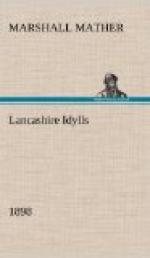‘Aw seed her mysel donce i’ th’ garden, on God’s good Sunday morn. I seed her donce like that brazened (impudent) wench did afore King Herod, him up i’ his study-winder skennin’ at her when he ought to ha’ bin sayin’ o’ his prayers. An’ aw yerd her sing some mak’ o’ stuff abaat luv, and sich like rubbidge. What sort o’ a wife dun yo’ co that? G’ me a lass as can strike up Hepzibah, and mak’ a prayer. It’s all o’ a piece—short weight i’ doctrin’, and falderdals i’ wives.’
And as Amos finished the delivery of this sentiment, and held the open hymn-book in his hand, he reached over to administer a blow on the ears of a child who was peeping through the window at a little bird trilling joyously on the deep-splayed sill outside.
During the pause between the close of Sunday-school and the commencement of morning service, congregation and scholars darkened the chapel yard in gossiping groups, each on the tiptoe of curiosity to catch a first glimpse of the bride of their pastor. All eyes were turned towards the crown of the hill which led up from the manse, and on which Mr. Penrose and his wife would first be seen. More than once an approaching couple were mistaken for them, and more than once disappointment darkened the faces of the waiting folk. With some of the older members weariness overcame curiosity, and they entered the doors, through which came the sound of instruments in process of tuning, while Amos Entwistle, cuffing and driving the younger scholars into the chapel, upbraided the elder ones by asking them ‘if th’ parson were the only chap as hed ever getten wed?’
At last the well-known form of the preacher was silhouetted on the brow of the hill, and by his side the wife whose advent had created such a prejudice and distaste, unknown though she was, among these moorland folks. The murmur of announcement ran round, and within, as well as without, all knew ‘th’ parson’s wife wor amang ’em.’
As the couple entered the chapel yard the people made way, ungraciously somewhat, and shot the young bride through and through with cruel stares. Mr. Penrose greeted his congregation with a succession of nervous nods, jerky and strained, his wife keeping her eyes fixed on the gravestones over which she was led to the chapel doors.
‘Sithee! hoo’s getten her yers pierced,’ said a loudly-dressed girl, a weaver at the factory in the vale.
‘Yi; an’ hoo wears droppers an’ o’,’ replied the friend whom she addressed.
‘Ey! haa hoo does pinch,’ critically remarked Libby Eastwood, the dressmaker of the village.
’Nay, Libby; yon’s a natural sized waist—hoo’s nobbud small made, thaa sees,’ said the woman to whom the remark had been made.
‘Well, aw’d ha’ donned a bonnet on a Sunday.’
‘Yi; so would I. An’ a married woman an’ o’—aw think hoo might be daycent.’
‘Aw’ll tell thee what, Mary Ann—there’s a deal o’ mak’ up i’ that yure (hair), or aw’m mista’en.’




